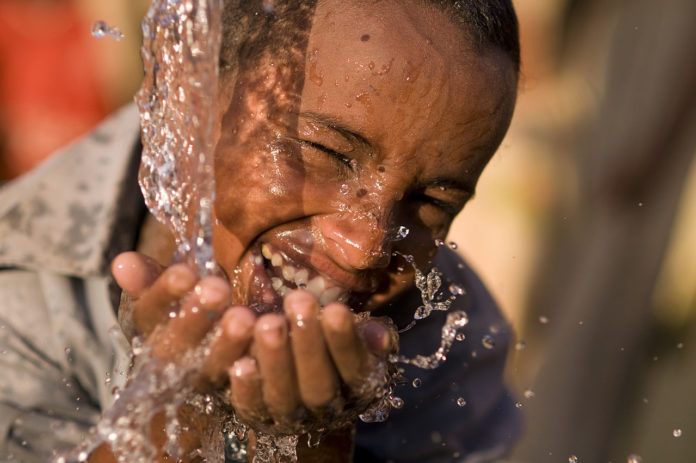Study in two locations in Bangladesh prove the efficacy of a water treatment device that delivers chlorine without electricity, in preventing diarrhoea
A novel water treatment device that delivers chlorine automatically via public taps without the need for electricity, reduced child diarrhoea by 23% compared with controls (156 cases out of 2,073 child measurements [7.5%] vs 216/2,145 [10%]). This worked over 14 months in two urban neighbourhoods of Bangladesh, according to a randomised trial following more than 1,000 children published in The Lancet Global Health journal.
Clean water is still a major problem in poor urban communities in low-income countries, where contamination by bacteria can lead to high rates of diarrhoeal diseases such as cholera and typhoid, harming children’s health and growth. Worldwide, an estimated one billion people who have access to piped water are drinking water that does not meet international safety standards.
Most previous research has focused on household-level water treatment interventions that require people to calculate the correct dosage and add their own chlorine daily—but these have had low uptake and failed to reduce diarrhoea, partly because they deliver a chlorine dose that makes chlorinated water taste and smell unpleasant.
In this study, the device used a low chlorine dose which increased taste acceptability and achieved high uptake while still improving drinking water quality.
“Chlorination is one of the cheapest and most widely available methods to make drinking water safe, but poor taste and bad smell of chlorinated water are major barriers to adoption,” explains co-author Dr Sonia Sultana from icddr,b (International Centre for Diarrhoeal Diseases Research, Bangladesh). “Our findings indicate that automated chlorine dosing below the taste detection threshold has the potential to be transformative by ensuring high adoption rates and will hopefully help progress towards the global target of universal access to safe and affordable drinking water.”
“Chlorination is one of the cheapest and most widely available methods to make drinking water safe, but poor taste and bad smell of chlorinated water are major barriers to adoption,”
Although one of the first field trials of this new technology, the authors say that chlorinating water at the point-of-collection could be an effective, scalable strategy in low-income urban settings to reduce diarrhoeal diseases. More research will be needed to determine where this technology should be implemented to maximise health benefits, as the intervention was more effective in Bangladesh’s capital city Dhaka city than in Tongi on the outskirts of the city.
“This novel, low-cost technology requires no behaviour change or effort by users—safe water comes straight out of the tap,” says Dr Amy Pickering from Tufts University, USA who led the research. “This point-of-collection approach to water treatment could be a transformative strategy for reducing gastrointestinal disease burden in low-income urban communities. We are now expanding the project to roadside water stands in Kenya, and working on a business model that could work in other countries.”
In this study, researchers used a novel treatment device that automatically dispenses small amounts of chlorine to water from public taps and shared hand pumps. In the device, water flows past solid tablets of chlorine which dissolve into the water to treat it.
Identical dispensers were installed at 100 shared water points in two low-income neighbourhoods in Bangladesh (Dhaka and Tongi) fed by piped water that is delivered intermittently, as is common in low-income settings. Water points were randomly assigned to have their drinking water automatically chlorinated (intervention) or to be treated with vitamin C (control group).
Between July 2015 and November 2015, 920 households with at least one child under the age of 5 years were assigned to the chlorine treatment (50 water points; 517 children) or control groups (50 water points; 519 children). Because of high migration, children could transfer into or out of the shared water points.
Every 2–3 months during the 14–month follow up period, caregiver-reported child diarrhoea (3 or more loose or watery stools in 24 hours) was measured alongside household and tap water quality (microbes, taste, smell), child weight, acute respiratory illness, and the presence of sufficient chlorine residual to prevent recontamination by dirty containers, utensils, or hands.
Before the trial began, the authors identified the concentration of chlorine that would be below the taste detection threshold for most residents, ensuring participants would not know which study group they were in, and would not be put off by the taste of chlorine. Blinding was largely successful during the triial, with most participants unable to accurately guess which intervention they had received. Nevertheless, nine communal water points in the intervention group were uninstalled, primarily due to individual complaints about the smell and taste of chlorinated water.
Chlorine residual was detected at the point of collection from shared taps 83% of the time in the treatment group compared to 0% of the time in the control group. E. coli contamination was detected in 15% of tap samples in the treatment group compared with 64% in the control group.
Results showed that, over 14 months, children in the treatment group had substantially less diarrhoea than those in the control group (156 cases out of 2,073 child observations [7.5%] vs 216/2,145 [10%]).


